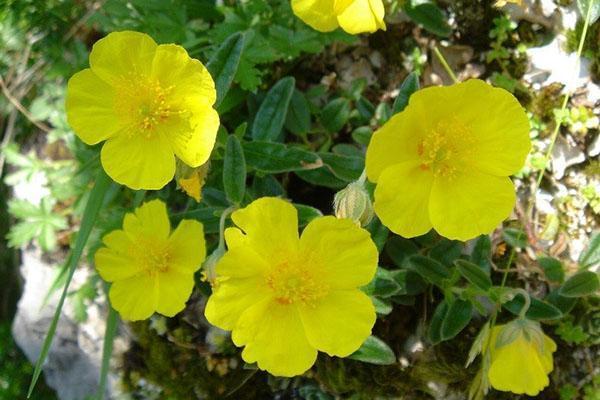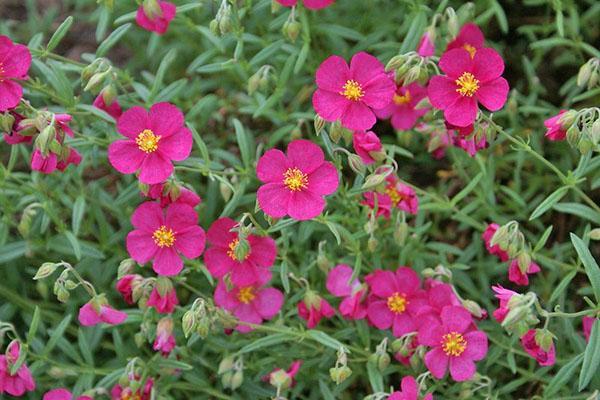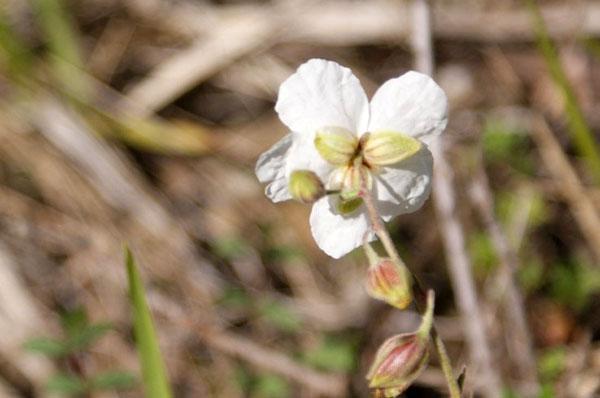Flower garden decoration - perennial sunflower
 Sunflower or heliantemum is a cute and unpretentious perennial plant that will be a wonderful decoration for your garden. The perennial sunflower is known for a variety of color colors: from pale white to bright orange or mysterious purple. A persistent shrub will take a fancy to unsightly rocky areas, decorate the garden with its cheerful appearance.
Sunflower or heliantemum is a cute and unpretentious perennial plant that will be a wonderful decoration for your garden. The perennial sunflower is known for a variety of color colors: from pale white to bright orange or mysterious purple. A persistent shrub will take a fancy to unsightly rocky areas, decorate the garden with its cheerful appearance.
The amazing name of a bright flower
Its main name, heliantemum, is a charming little plant derived from two Greek words: the sun - "helios" and the flower - "anthos". The people called him the sunflower. This name was given for a reason: the buds of a half-shrub open with the sunrise and “watch” the luminary all day, turning their petals to its rays.
And how many romantic nicknames the sunflower has received for its endurance and modest beauty: "mountain rose", "stone rose", tenderloin, "frosty grass" and "sun rose".
Botanical description

Stems are straight or branching (less often, creeping along the soil), their height reaches 10-50 cm (depending on the species). The leaves are elongated, oval in shape with pointed tips. The leaves can be of any color: from deep green to pale green. Medium-sized flowers with five petals. The bright color of petals and stamens attracts insects for pollination. After pollination, a fruit-box grows on the tender, inside which there are many seeds.
It is difficult to establish the exact homeland of heliantumum. One thing is certain: this wonderful flower came to us from afar. Due to its stamina, the neder has taken root from North Africa to the Arctic belt of Russia.
Sunflower planting and care
 Although the heliantemum is an unpretentious shrub, it, like every plant, needs to create suitable conditions for life. Consider just a few features of the sunflower, and it will delight you with its beauty for a long time:
Although the heliantemum is an unpretentious shrub, it, like every plant, needs to create suitable conditions for life. Consider just a few features of the sunflower, and it will delight you with its beauty for a long time:
- Unlike many garden flowers, heliantemum does not need additional feeding (they stimulate abundant growth of leaves and stems, while the flowers become smaller).
- Sunflower prefers warm, well-lit places. Areas should be dry (drained) with rocky, calcareous, loamy or sandy soil.
- Heliantemum should be watered only occasionally, during dry times;
- After the shrub has bloomed for the first time, it needs to be trimmed lightly. This will keep the shape of the plant and prevent it from overgrowing.
- Although the sunflower is a hardy plant, it is sometimes attacked by common fungal disease under the name septoria (white spot). It is necessary to quickly remove the infected leaves, then burn them. The tender itself must be sprayed with a 1% solution of Bordeaux mixture. This is the only way to avoid the death of the plant.
Some types of sunflower have varying degrees of frost resistance. For example, red flowers are more thermophilic, quickly die in the cold. They are often used as annuals.
Varieties of sunflower
Now more than 70 varieties of perennial sunflower are known.In the wild, the persistent dwarf shrub is found in the savannas of Africa, the Alps, the Mediterranean coasts, the Caucasus and the Arctic regions. Now this flower is gaining popularity among breeders. Heliantemum, which is very easy to plant and care for, has become a permanent inhabitant of gardens around the world. Some varieties of tenderloin are very interesting.
Large-flowered sunflower
 Unlike its wild counterparts, this variety is distinguished by its large flowers (up to 4 cm in diameter). The buds and stamens are bright yellow. The leaves of the large-flowered tender are wider, of a delicate light green hue. The stems are also wide, reaching a height of about 30 cm.
Unlike its wild counterparts, this variety is distinguished by its large flowers (up to 4 cm in diameter). The buds and stamens are bright yellow. The leaves of the large-flowered tender are wider, of a delicate light green hue. The stems are also wide, reaching a height of about 30 cm.
Monofilament sunflower
 Mono-leaved sunflowers are the most famous and popular variety. His homeland is Southern Europe and the Mediterranean. Stems are long (up to 30 cm), creeping along the soil. Leaves are oval, silvery-green, pleasant to the eye. In the natural environment, the flowers are colored yellow, and in domesticated varieties - orange, pink, crimson, red, lavender.
Mono-leaved sunflowers are the most famous and popular variety. His homeland is Southern Europe and the Mediterranean. Stems are long (up to 30 cm), creeping along the soil. Leaves are oval, silvery-green, pleasant to the eye. In the natural environment, the flowers are colored yellow, and in domesticated varieties - orange, pink, crimson, red, lavender.
Gray sunflower
 A miniature subspecies of the scrub found in the arid and rocky regions of Northern Europe (including the UK) and North Africa. The leaves are small, drooping down, of a grayish hue (for which the name). The buds are small, lemon yellow or white.
A miniature subspecies of the scrub found in the arid and rocky regions of Northern Europe (including the UK) and North Africa. The leaves are small, drooping down, of a grayish hue (for which the name). The buds are small, lemon yellow or white.
Apennine sunflower
 One of the largest varieties of heliantemum: the height of its stems can reach 50 cm! His homeland is the dry regions of the mountain ranges of Europe. The leaves are elongated, covered with a grayish downy. The flowers are delicate pink with a yellow border or snowy yellow.
One of the largest varieties of heliantemum: the height of its stems can reach 50 cm! His homeland is the dry regions of the mountain ranges of Europe. The leaves are elongated, covered with a grayish downy. The flowers are delicate pink with a yellow border or snowy yellow.
Arctic sunflower
 The arctic sunflower is the only northern species of heliantemum. A photo of this bold flower will charm anyone. A small neat (almost perfectly round) bush, the only one of its entire southern family, settled in the harsh regions of the north. The flowers are very bright yellow, and the height of the cover reaches about 40 cm.
The arctic sunflower is the only northern species of heliantemum. A photo of this bold flower will charm anyone. A small neat (almost perfectly round) bush, the only one of its entire southern family, settled in the harsh regions of the north. The flowers are very bright yellow, and the height of the cover reaches about 40 cm.
The arctic sunflower is currently considered endangered and is listed in the Red Book.
Alpine sunflower
 As the name suggests, this species lives on the slopes of the Alps. The plant is undersized: the stems reach a height of 10-15 cm. The leaves and flowers are small. In adulthood, the stems have an unusual brownish tint.
As the name suggests, this species lives on the slopes of the Alps. The plant is undersized: the stems reach a height of 10-15 cm. The leaves and flowers are small. In adulthood, the stems have an unusual brownish tint.
Hybrids
 Any natural or domesticated subspecies crossed with each other are called hybrid heliantemums. They are distinguished by high decorative qualities, various colors and frost resistance.
Any natural or domesticated subspecies crossed with each other are called hybrid heliantemums. They are distinguished by high decorative qualities, various colors and frost resistance.
Reproduction of heliantemum
 A photo of how to properly organize the landing of the heliantemum can be found below. This flower is unpretentious to living conditions, so it easily adapts to any area.
A photo of how to properly organize the landing of the heliantemum can be found below. This flower is unpretentious to living conditions, so it easily adapts to any area.
It is best to sow flowers in small pots until the seedlings are strong and ready to move to the garden.
You can grow tenderloin yourself. There are two ways of propagation of this flower: seed and vegetative (cuttings). Which one is better is for the gardener to choose.
 Growing sunflower seeds from seeds is much easier than grafting. This way you will harm the plant less and get guaranteed results. A bag of seeds can be bought at any store or by hand. Next, determine how you plant the tender. Sunflower, sowing seedlings of which can be started from the beginning of April.
Growing sunflower seeds from seeds is much easier than grafting. This way you will harm the plant less and get guaranteed results. A bag of seeds can be bought at any store or by hand. Next, determine how you plant the tender. Sunflower, sowing seedlings of which can be started from the beginning of April.
Seeds planted in a cotton wool or damp cloth will hatch in 10-15 days.
If you want to plant seeds in a greenhouse, do it at the end of April. In case of frost, cover the seedlings with spunbond.
Seedlings should be placed at a distance, because by summer the seedlings will turn into lush bushes. Unfortunately, the bushes grown in this way will bloom only after a year or two.
 If you don't want to wait, you can try to remove the tenderloin by cuttings. In mid-July, semi-lignified cuttings are cut from an adult plant (preferably with three or more internodes).
If you don't want to wait, you can try to remove the tenderloin by cuttings. In mid-July, semi-lignified cuttings are cut from an adult plant (preferably with three or more internodes).
It is better to take the lower parts for the cuttings. The apex hardly rooted.
Leave two leaves at the cuttings, remove the rest. Dip the lower ends of the cuttings in a root-forming stimulator and plant the babies in plastic bottle (better in the shade). Use a 1 to 2 cm layer of sand as a substrate for the cuticle. Water as needed.
The perennial sunflower is a wonderful plant that many gardeners liked. This shrub takes root in any area.
How do you think people should read the text of the article if you closed it with your social networks? http://prntscr.com/nl7l71
when you hover over the buttons, arrows appear that can hide them